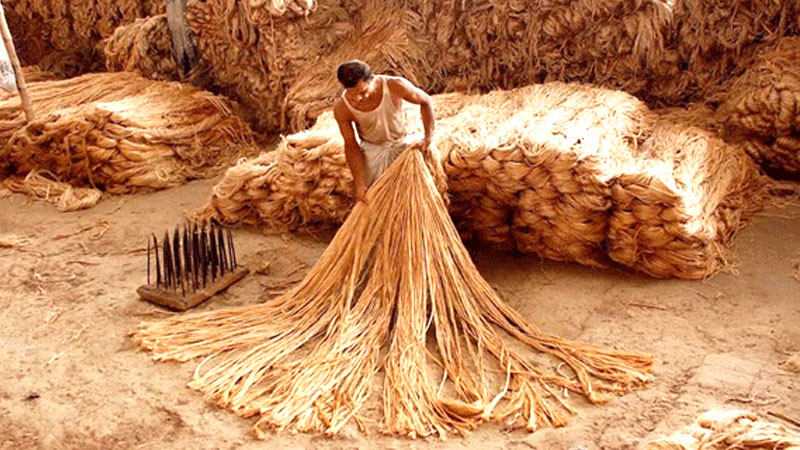huge jute export potential emerges
Experts suggest improving quality, diversifying products

In order to revive and regain reputation of Bangladeshi jute in the international market experts suggested focusing on enhancing quality and diversifying the products.
They strongly suggested strengthening diplomatic relations to create demand of the once famed ‘golden fibre’ in countries where there are potentials in exporting jute products.
Such optimistic thinking of the experts studying jute came at a time when the export earnings from the jute and jute products have increased by 38.23 percent to $103.51million in July of the current fiscal year (2019–20).
On suchprogressive note the experts expressed confidence on reviving jute industry saying that the government will have to extend all out cooperation to its local entrepreneurs so that they can produce international quality jute products, train manpower and assure quality as per the demands of the international buyers.
They said that the products need to be innovative and attractive so that foreign buyers can place orders in bulk quantities.
Amid falling export trend, jute and jute goods are still the second largest export product of Bangladesh next to ready-made garments (RMG).Bangladesh is the second largest exporter of jute after India at present.
M Sajjad Hussain Sohel,President of Bangladesh Jute Goods Exporters Association (BJGEA) told Bangladesh Post, “The export income of jute and jute products has increased as the price of our products has been increased in the global market, though not the volume of exports.”
“Although the demand for the product has also increased in the world market along with the price, we cannot meet the demand properly for lack of maintaining quality,” he mentioned.
He also said that although price of the jute products has gone up, but the products’ quality has not been enhanced in comparison.
Sajjad informed that the demand for jute and jute products has increased in developed countries including Europe and America due to the reduction in the use of polythene in the world in response to demands for using environment friendly bio-degradable products.
“The demand for jute products is increasing day by day,” he said adding that, “Sri Lanka has recently banned use of polythene bags. Now the demand for jute bags in Sri Lanka would also increase.”
The leaders of the exporters' association said the jute industry needs to be brought back to life again to survive in the long run for export growth of jute and jute products. They pointed out that as polythene use in the global market is gradually falling under pressure from environment activists, it is time to grab the opportunity and take the lead for jute export in the international market.
That is why, the demand for jute and jute products in the local market should be increased first, they added.
A high official of textiles and jute ministry said the government will set up advanced technology-based jute and jute seeds production units for increasing the output of high-quality jute and obtaining self-sufficiency in the production of jute seeds.
He said, “The government has recently shut down all the state-run public jute mills to rejuvenate jute sector as the government has incurred huge losses over the time from public jute mills.”
“The government is now going to reopen the mills under the public-private partnership arrangement with the application of world’s most modern technology,” he added.
Rashedul Karim Munna,President of Bangladesh Jute Diversified Products Manufacturers and Exporters Association said the potential of jute is endless due to the production of varieties of products.
“Even if it can capture 10 percent of the potential international jute market, it is possible to earn Tk 50,000 crore a year with this jute alone,” he added.
“Making billions of dollars a year from the jute industry next year is not a dream at all,” he said, adding, “For this, the country has to facilitate setting up of modern technology-based jute factories.”
In addition, in order to ensure jute-goods entry into the international market, it is necessary to increase research and create skilled manpower in the country to manufacture jute products as per the demand of the global and domestic markets.
“Besides, a large investment is required to increase the mechanical facilities,”Munna said adding that, “For this, the government needs to provide all out support to the private sector for their growth like in the garments industry. Healthy competition in the RMG industry has lifted the quality of products now recognized all over the world.”
Abdus Salam Murshedy, President of Bangladesh Exporters Association, told Bangladesh Post, “The government needs to create and recruit skilled manpower in this sector and diversify products as part of its readiness to capture the international jute market.”
The export earnings from the jute and jute-made goods witnessed a healthy growth during the last fiscal despite the ongoing worldwide shutdown due to the coronavirus pandemic.
The earnings from this sector secured second place after the readymade garments (RMG) pushing down the leather sector to the third place for the first time since losing its glory as the most export earning product as well as the golden fibre.
Export earnings from most of the products, including the RMG, of the country have shown negative growth during the period.
The country’s overall export earnings stood at around $33.67 billion in the last fiscal, which is 16.93 percent less than the previous fiscal.
On the other hand, the country’s earnings from RMG exports witnessed a negative growth to hit $27.94 billion during FY20 against $28.49 billion during the same period a year earlier, posting a 18.12 percent negative growth.
The earnings also missed target set for the period by 26.83 percent.
However, the export earnings from the jute and jute products have increased by 38.23 percent to $103.51million in July of the current fiscal year (2019–20).
This figure was $74.26 million in the same period in the previous fiscal year.




